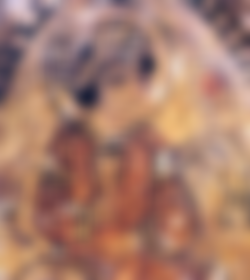Of the Fatimid caliphs in Egypt, Al-Hakim is one of the most difficult to get hold of. His behaviour was apparently unpredictable and violent and he is sometimes described as "The Mad Caliph", especially in Western literature. Nevertheless, he seems to have inspired to a very strong loyalty amongst his followers and he benefited from education and learning. He does not get less interesting by that he never actually died. Well, of course he did at some time, but nobody knows when, where or how. As a 36-year-old caliph, he suddenly disappeared in 1021. One only found his donkey and some bloody garments outside Cairo. Maybe he was murdered.
Abu Ali Mansur Al-Hakim bi-Amr Allah (985-1021?), or simply Al-Hakim or Al-Hakim bi Amr Allah, was the 16th Ismaili Imam, the sixth Fatimid caliph, and the first who was born in Egypt. He succeeded his father in 996.

Initially, Al-Hakim was kindly inclined to Christians. His mother was a Melchite Christian, and his maternal uncles were Patriarchs in the Melchite Church. He saw the Sunnites and the Sunnite Caliphate in Baghdad as his main opponent.
Gradually he came to change over time and develop a strong aggression against Christians and Jews that culminated when he, in 1009, destroyed the Church of the Holy Sepulchre in Jerusalem, one of the holiest sites in Christendom. According to belief, Christ's resurrection took place there. One can say that it was the first time that there were serious tensions between Muslims on one hand, and Christians and Jews on the other. Until then, the co-existence had worked relatively well. The event helped to develop the idea of the Crusades, despite the fact that Al-Hakim's successor and son allowed Byzantine Emperor Constantine IX to rebuild the church. But the damage was done and with the Crusades, tensions and conflicts came to dominate the area for centuries. (It is an interesting fact that the key of the church is held, and the opening and closing of the gate is managed by representatives from two Muslim families, Nusseibeh and Joudeh. The six Christian Churches which own the church are always fighting for power and cannot keep together.)
At a later stage, Al-Hakim once again showed greater tolerance to Christians and Jews, but more aggression against other branches of Islam than his own. Especially against Sunni Islam. He stimulated the Ismaili mission. Born from Ismaili extremism, the Druse religion began to take shape in 1017. It saw Al-Hakim as an incarnation of God, and there is evidence to suggest that he believed in his own divinity.
Al-Hakim had wide diplomatic relations, which stretched all the way to China. He favoured learning and education, and seemed to have had many good qualities. How much of what is said about his violent temper that is true and what is later anti-Fatimid or anti-Ismaili propaganda, is impossible to know.

In Cairo, Masjid al-Hākim is "Al-Hakim's Mosque" (official name: "Jame-ul-Anwar"), which was completed in 1030. It was later used as a prison, stables, and school, and eventually it eroded to a veritable ruin. Rebuilt as late as the 1980s and 1990s, the result is disregarded by many because it is a new building - a copy of the old, not a restoration of the old one. However, on the inside there are a lot of remains from the old mosque. Al-Hakim's Mosque is located in "Islamic Cairo", near the northern gate, Bab Al-Futuh.
I took the following two photos (Copyright © Meleonymica. All rights reserved.) on the inner courtyard of Al-Hakim's mosque on a night in 2010. The light was bad and I had only a relatively primitive mobile camera, so the quality is not all that good. However, they clearly show that it is a suggestive atmosphere there at night.


Copyright © 2018, 2021 Meleonymica/Mictorrani. All Rights Reserved.
Read also my first article about Fatimid Egypt: "The Fatimids of Egypt, The Only Shi'ite Caliphate in History"
All my articles about Egypt can be found here.
You find all my writings on Read.Cash, sorted by topic, here.
If you are interested in history and Egyptology, join my community History, Myths, Legends & Mysteries (be45).



